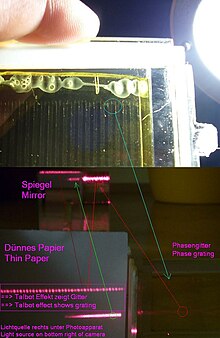Phase grating
Phase gratings are optical diffraction gratings that influence the phase of the light wave passing through. Ideal phase gratings are completely transparent, the light is delayed at the grating bars due to the refractive index of the material. Variants:
- Material is thicker on the webs or has a different refractive index
- Transitions between bars and gaps are erratic or fluid
- Grating is transparent (transmission grating) or reflected (reflection grating)
A delay of half a wavelength , for example, corresponds to a 180 ° phase shift.
effect
Phase gratings are transparent and therefore not easily visible. However, diffraction (as in any optical grating ) can be used:
- A thin monochromatic laser beam is split into several directions.
- For better results, a (collecting) lens is placed behind the grating and an observation screen in the focal point of the lens. The lens then groups light rays according to their deflection angle. This requires a sufficiently parallel light beam, but allows wider beams and coarser grids.
- In the case of very coarse grids, the small deflection angles can be represented with the Talbot effect .
application
Phase gratings can have these advantages over amplitude gratings :
- Energy: The light intensity is fully retained.
- Manufacturing: phase grids can e.g. B. consist of a standing wave (ultrasound, light). The wave modifies the refractive index of the medium. Acousto-optical modulators are an example .
- X-ray: X-rays are not perfectly absorbed by any material. Therefore, the bars in amplitude gratings are never perfectly absorbent. Phase gratings, on the other hand, can be manufactured well.
interpretation
Phase gratings can be designed, for example, to delay light of a predetermined wavelength by half a wavelength . If the material of the grating has the refractive index , the bars of the grating must be higher by
If the "webs" of the grating have a higher refractive index than the "columns" of the grating, the height of the grating is equal to .
Derivation: The material does not change the frequency of the light compared to the vacuum. Because of the reduced phase velocity of light, the wavelength ( ) in the material decreases . This results in the condition:
- .
Individual evidence
- ↑ KIT Institute for Microstructure Technology ( Memento of the original from February 5, 2012 in the Internet Archive ) Info: The archive link was automatically inserted and not yet checked. Please check the original and archive link according to the instructions and then remove this notice. , Keyword "X-ray optics", section X-ray grids












